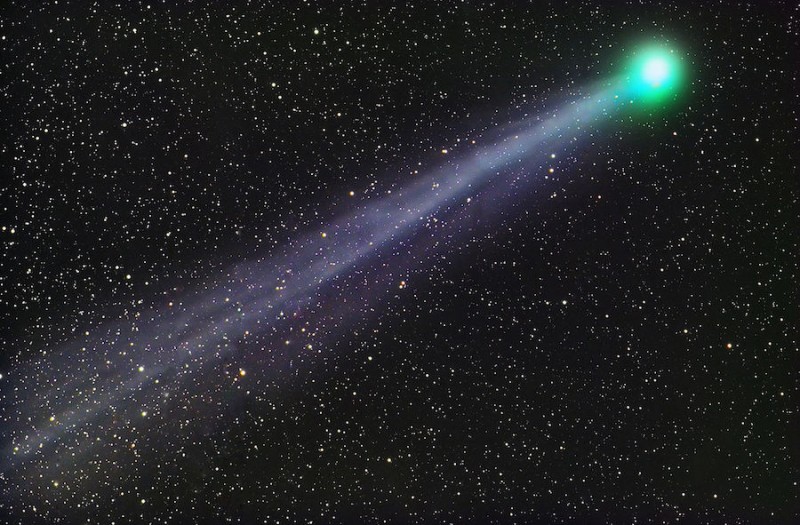News
Watch the Moon Swing by Jupiter Tonight!
Saturday, June 23rd 2018 04:51 PM
Starting in the southern sky after sunset on the evening of Saturday, June 23, the waxing gibbous moon will sit less than 4 degrees to the upper left of bright Jupiter. The two objects will cross the sky together during the night, with the sky's rotation carrying the moon higher and above Jupiter after midnight. Meanwhile, the moon's separation from the bright planet will noticeably increase as the moon slides eastwards in its orbit.
On Saturday night (June 23), should local weather conditions permit, you'll be able to enjoy a view of a waxing gibbous moon hovering near the "king of the planets," Jupiter. Both will be about halfway up in the southern part of the sky as darkness begins to fall. The moon, which will be three and a half days past first-quarter phase — 85-percent illuminated by the sun — will be situated just above and to the left of Jupiter, a distance measuring roughly 4 degrees.
Here's how to gauge how wide 4 degrees is: Yo...
Read More
Read More
Three planets found around dust-shrouded star
Friday, June 15th 2018 09:32 PM
Two teams of astronomers using the Atacama Large Millimetre/submillimetre Array – ALMA – have spotted three newly formed planets orbiting an infant star in its dusty protoplanetary disc. It is the first detection of its kind.
Confirming the presence of young worlds in such dust-shrouded discs is difficult, but the teams, working independently, used a novel technique to spot the otherwise hidden worlds: studying unusual patterns in the flow of carbon monoxide molecules swirling around the star.
“Measuring the flow of gas within a protoplanetary disc gives us much more certainty that planets are present around a young star,” said Christophe Pinte of Monash University in Australia and Institut de Planétologie et d’Astrophysique de Grenoble in France, lead author of a paper describing the discovery. “This technique offers a promising new direction to understand how planetary systems form.”
Richard Teague, an astronomer at the Universi...
Read More
Read More
The Sky This Week
Tuesday, June 12th 2018 05:24 PM
Tuesday, June 12
Mars rises shortly before midnight local daylight time and climbs nearly 30° high in the south by the time morning twilight commences. Although it is still a month and a half away from its late July opposition, the Red Planet appears noticeably brighter than it did just a week ago. Shining at magnitude –1.6, it is the third-brightest point of light in the night sky after Venus and Jupiter. If you point a telescope toward Mars this morning, you’ll see a 17"-diameter disk that sports several subtle surface features.
Wednesday, June 13
Although Saturn will reach opposition and peak visibility two weeks from today, observers will be hard-pressed to see it as inferior this week. The ringed planet rises shortly after 9 p.m. local daylight time and appears highest in the south around 2 a.m. Saturn shines at magnitude 0.1 and stands out against the background stars of northern Sagittarius. If you target the planet through binoculars this week, yo...
Read More
Read More
Astronomers find source of stars' mysterious microwaves
Tuesday, June 12th 2018 05:17 PM
Mysterious streams of microwaves that come from far across the galaxy have been traced to immense clouds of spinning diamonds that swirl around newly-born stars.
Astronomers have been stumped by the strange waves since they were first spotted more than 20 years ago, but now appear to have solved the puzzle after training US and Australian telescopes on rings of dust that circle stars about 500 light years from Earth.
Observations from the Green Bank Telescope in West Virginia and the Australia Telescope Compact Array in New South Wales found that the microwaves emanate only from stars which are surrounded by vast quantities of diamond particles which rotate tens of billions of times per second.
The diamond dust motes are only a millionth of a millimetre wide and so light that when they bump into each other they spin fast enough to emit microwaves which spread out across the universe, the scientists report in Nature Astronomy.
Researchers first became aware of what are called...
Read More
Read More
Extremely Large, Extremely Expensive: The Race for the Next Giant Telescopes
Monday, June 11th 2018 11:44 PM
It is high noon, again, for astronomers who want to erect a gigantic telescope on Mauna Kea, the grand volcano on the Big Island of Hawaii.
On June 21, the Supreme Court of Hawaii will hear oral arguments in Honolulu on whether to approve a building permit for the telescope, which would be the biggest and most expensive in the Northern Hemisphere.
This same court rescinded the telescope’s permit two-and-a-half years agoon procedural grounds, after protests had prevented construction on the mountaintop.
The Thirty Meter Telescope (named for the diameter of its main light-collecting mirror) has been 15 years in the planning. It would be one of three gargantuan telescopes now in the works that could transform astronomy in the 21st century.
If they don’t get clearance to start building on Mauna Kea soon, the Thirty Meter astronomers say they will build it on La Palma in the Canary Islands, off Africa, where the Roque de los Muchachos O...
Read More
Read More
Introducing the LX65 from Meade
Friday, June 8th 2018 07:48 PM
Check out the new LX65 from Meade on buytelescopes.com
Meade’s Founder, John Diebel was a visionary who was determined to provide amateur astronomers with quality products at a reasonable price and great consumer experience. At Meade, we believe the universe should be accessible at a moment’s notice, and the new LX65 Series combines advanced features and premium optics in an easy-to-use telescope system.
SINGLE FORK ARM MOUNTThe LX65 features a newly designed single arm mount with Meade’s AudioStar® Hand controller. This new mount is compact, yet sturdy, providing a great combination of portability and performance. Additionally, the LX65 has the ability to hold two optical tubes, making your experience twice as enjoyable! With its quick and portable setup, you’re ready to start observing in minutes. The LX65 system breaks down into 3 compact pieces and does not require any tools, making it a breeze to transport to your favorite dark sk...
Read More
Read More
What’s Going On with Tabby’s Star? It’s Complicated
Wednesday, June 6th 2018 06:35 PM
Once again, KIC 8462852 (aka Tabby's Star or Boyajian's Star) is proving how difficult it is to observe a strange system from afar.
This is the star made famous for potentially hosting alien megastructures. Observations have since firmly ruled out that option, but that aliens were mentioned at all shows just how weird the star is.
Tabby’s Star dips in brightness — sometimes by just 1% and sometimes by up to 20% — over days or weeks, before recovering to its previous luminosity. Yet it's fading too, over longer timescales of years and even decades. Dust explains the short-term dips, but new research shows that the long-term fade could be due to something else entirely.
Tabby's Star: Update
After the discovery of Tabby's Star's strange behavior, astronomers began monitoring the star for variability. When the star's brightness began dipping again last year, observatories around the world joined the monitoring campaign, catching four dips that togethe...
Read More
Read More
Explore the Milky Way's Monster Black Hole with This Virtual Tour
Monday, June 4th 2018 05:45 PM
Last month, scientists announced the discovery of thousands of black holes at the heart of our galaxy. Now, you can explore the monster black hole at the core of the Milky Way that's surrounded by that black-hole swarm, thanks to a new virtual tour released by NASA.
The individual black holes are estimated to be five to 30 times the mass of our sun, and all were found within three light-years from the monster black hole, called Sagittarius A*.
"Researchers combed through data from NASA's Chandra X-Ray Observatory, looking for possible black holes in close orbit with a star," researchers said in a new video posted on the Chandra website. "They found about a dozen strong black-hole candidates within a very short distance of the supermassive black hole at the galactic center. This implies the presence of other undetected stellar-mass black holes. Up to a thousand stellar-mass black holes could be present."
The video zooms in on Sagittarius A*, with suspect...
Read More
Read More
Vast ionized hydrogen cloud in the Whirlpool Galaxy revealed by ultra-sensitive telescope
Monday, June 4th 2018 05:27 PM
Astronomers have been keenly peering into M51, or the Whirlpool Galaxy, since the 1800s, its signature spiral structure informing the earliest debates over the nature of galaxies and the Cosmos at large.
But no one -- not with the naked eye or with increasingly powerful modern telescopes -- has ever seen what Case Western Reserve University astronomers first observed using a refurbished 75-year-old telescope in the mountains of southwest Arizona.
"I literally looked at the image and said, 'What in the world is that?'" said Case Western Reserve astronomy professor Chris Mihos.
What it was turned out to be a massive cloud of ionized hydrogen gas spewed from a nearby galaxy and then essentially "cooked" by radiation from the galaxy's central black hole.
Mihos and a trio of collaborators -- led by then-graduate student Aaron Watkins, and including Case Western Reserve Observatory Manager Paul Harding and University of Wisconsin astronomer Matthew Bershady -- wrote about the di...
Read More
Read More
Introducing the LX85 Series from Meade
Friday, June 1st 2018 11:18 PM
Check out the entire LX85 Series, available for preorder now! Orders shipping late August 2018.
The LX85 SERIES
GERMAN EQ MOUNTS TO GROW AS YOU DO.Meade’s new LX85 Series features a high-quality, portable, GoTo, German equatorial mount with AudioStar® Hand box. The LX85 Series is the perfect choice for the cultivated observer and astro-imager looking to chase deep sky objects! Use as a stand-alone mount or maximize your viewing potential with an array of different optical tubes to choose from. Meade’s LX85 Series will keep you looking up for many years to come and sets a standard for mid-sized telescopes at a great price.
GOTO MOUNT WITH AUDIOSTAR®The LX85 features a Vixen-style dovetail receiver for mounting observing equipment up to 33 lbs., coupled with a sturdy build and low-cog servo-motors that ensure smooth tracking performance. This stable mount can impressively handle slight load imbalances with ease. With its built-in integer gearing moto...
Read More
Read More







